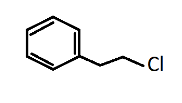Answer
38.7k+ views
Hint: In Aryl alkyl halides, aryl stands for aromatic compound, alkyl stands for any compound having carbon and hydrogen atoms only and halide stands for halogen family members such as fluorine, chlorine, bromine, etc.
Complete step-by-step solution:
Alkyl aryl halide is formed when one or more hydrogen atoms in an aromatic alkane are replaced by halogen atoms like fluorine, chlorine, bromine or iodine. This can be seen in option (C).
1-chloro-2-phenylethane contains benzene as an aryl group and chloroethane as an alkyl halide with ethane being the alkyl group and chlorine being the halide substituent.

While option (D), toluene has no halogen in it, so it can’t be an aryl alkyl halide as it has only methyl groups on benzene rings. But if one of the hydrogens of methane is replaced by any halogen, it will become aryl alkyl halide.
Similarly, we see in option (B), two halogens are present as substituents but no alkyl group is attached to the benzene ring. So, it is just an aryl halide.
Hence, the correct option is (C).
Note: Option (A) also accounts for the same because it has a chlorine at ortho position of benzene ring and toluene, methyl group on the benzene ring. This might look as an alkyl aryl halide, but it is just an aryl halide, as the halide is bonded directly to the benzene ring in it.
Complete step-by-step solution:
Alkyl aryl halide is formed when one or more hydrogen atoms in an aromatic alkane are replaced by halogen atoms like fluorine, chlorine, bromine or iodine. This can be seen in option (C).
1-chloro-2-phenylethane contains benzene as an aryl group and chloroethane as an alkyl halide with ethane being the alkyl group and chlorine being the halide substituent.

While option (D), toluene has no halogen in it, so it can’t be an aryl alkyl halide as it has only methyl groups on benzene rings. But if one of the hydrogens of methane is replaced by any halogen, it will become aryl alkyl halide.
Similarly, we see in option (B), two halogens are present as substituents but no alkyl group is attached to the benzene ring. So, it is just an aryl halide.
Hence, the correct option is (C).
Note: Option (A) also accounts for the same because it has a chlorine at ortho position of benzene ring and toluene, methyl group on the benzene ring. This might look as an alkyl aryl halide, but it is just an aryl halide, as the halide is bonded directly to the benzene ring in it.
Recently Updated Pages
silver wire has diameter 04mm and resistivity 16 times class 12 physics JEE_Main

A parallel plate capacitor has a capacitance C When class 12 physics JEE_Main

Let gx 1 + x x and fx left beginarray20c 1x 0 0x 0 class 12 maths JEE_Main

A series combination of n1 capacitors each of value class 12 physics JEE_Main

When propyne is treated with aqueous H2SO4 in presence class 12 chemistry JEE_Main

Which of the following is not true in the case of motion class 12 physics JEE_Main

Other Pages
The resultant of vec A and vec B is perpendicular to class 11 physics JEE_Main

when an object Is placed at a distance of 60 cm from class 12 physics JEE_Main

Differentiate between homogeneous and heterogeneous class 12 chemistry JEE_Main

Oxidation state of S in H2S2O8 is A 6 B 7 C +8 D 0 class 12 chemistry JEE_Main

If a wire of resistance R is stretched to double of class 12 physics JEE_Main

Dissolving 120g of urea molwt60 in 1000g of water gave class 11 chemistry JEE_Main



